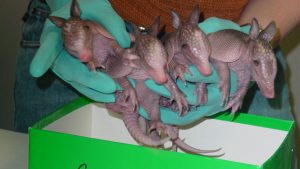Yes, in fact armadillo quadruplets are the standard! Armadillos practically always have four cute (and identical) armadillo quadruplets.
This may sound bizarre, but it’s the truth! Armadillo mamas ovulate (release) one egg which is then fertilized. This newly fertilized egg then proceeds to divide into two separate organisms before each of those splits again! This results in four identical armadillo quadruplets!

Now that we’ve established HOW armadillo mothers do this, let’s discuss why
Generally, genetic diversity is key for the survival of a species. If each member of a species has a unique genetic code then the overall chance of survival for the species is increased. This is because if one genetic make-up/trait is not suitable for a certain environment, that individual is unlikely to reproduce. On the flip side, a genetic makeup/trait that is suited for a particular environment is likely to live for longer and thus reproduce.
That’s Charles Darwin’s ‘survival of the fittest’ theory in a nutshell. Animals with genetics that make them better suited to their environment will live longer and reproduce, passing on those genetics. Generally, this requires a lot of genetic variation within a species; like siblings that don’t have identical DNA!

So why do armadillos do it? Why do they have four babies that are essentially clones of one another rather than four genetically unique babies? I’d love to tell you, but sadly the answer to this question remains a mystery!
Other animals with multiple babies
For lots of animals, multiple babies at once are the norm, albeit non identical ones. Dogs, for example, usually have litters of around 5 puppies at a time. Other animals, such as sheep and goats, commonly give birth to two babies at once: what humans call fraternal twins! (in case you didn’t know, fraternal just means twins that aren’t identical).
We don’t actually know if identical twins are more, less or even equally likely in animals when compared to humans. We don’t exactly test every baby that is born to see if they’re genetically identical and to us humans, all animals of the same species look alike!
Despite this uncertainty of identical birth likelihood, one thing can be said for sure. Armadillos seem to be the only animal that consistently and almost exclusively has identical children as a rule. What makes this even weirder, is that it is always quadruplets. That means that there is not one embryonic division, not two embryonic divisions, but three!
 (Britain’s oldest identical triplets!)
(Britain’s oldest identical triplets!)
For context, in humans around 1 in 30 births result in twins, and of that only a third will be identical. That’s one in ninety births! Triplets are even rarer with 1 in 10,000 births resulting in triplets and a whopping 1 in 200,000,000 births being identical triplets! I’d give the statistics for quadruplets but i think the numbers would be too big to type!
Knowing those figures for humans really puts into perspective how bizarre armadillo births are. If identical twins are so rare in humans, let alone identical triplets or quadruplets, then how do they do it? How do armadillos have identical quadruplets EVERY. SINGLE. TIME. The short but sad answer is, we don’t know!
Extra information
Animal-Club provides animal parties or animal handling workshops. You will be able to see, learn and interact with many wonderful animals with the help of our presenters. Our mobile zoo has many friendly animals such as rabbits, tarantulas, geckos, vinegaroons and more, perfect for an animal party. We can also come over to your school for an animal school visit or arrange for an animal workshop with us where the children can learn about looking after animals and animal behaviour, and have fun too.



